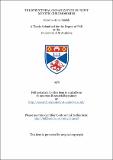Files in this item
The structural organization of newt mitotic chromosomes
Item metadata
| dc.contributor.advisor | Callan, Harold Garnet | |
| dc.contributor.author | Rudak, Edwina-Anne | |
| dc.coverage.spatial | iii, 92 p. | en_US |
| dc.date.accessioned | 2018-06-13T15:38:24Z | |
| dc.date.available | 2018-06-13T15:38:24Z | |
| dc.date.issued | 1976 | |
| dc.identifier.uri | https://hdl.handle.net/10023/14028 | |
| dc.description.abstract | Chapter I. After a period of culture at low temperature, mitotic chromosomes of the newt species Triturus cristatus and T. vulgaris show a characteristic pattern of predominantly pericentrically located secondary constrictions. The chromatin in these constricted regions stains intensely with Giemsa. When mitotic chromosome preparations are stained according to a C-banding technique, the centromeres and the interstitial regions which stain differentially after cold-treatment, stain intensely with Giemsa. Electron micrographs of sections through metaphase chromosomes in tail-fin cells of cold- and colchicine-treated larvae show that the chromatin fibres are more densely packed in the constricted regions than elsewhere. Hypotonically treated spermatogonia or tissue-culture cells of T.c. carnifex show spiral structure throughout the metaphase chromatids. Chapter II. T.c. carnifex skin fibroblasts can be maintained in monolayer culture in a predominantly diploid state for more than 14 months. The cells grow at 25°C in Eagles' MEM supplemented with 10% foetal calf serum and glutamine. The cell generation time is approximately 4 days. This is the only diploid urodele cell line maintained in any laboratory. Chapter III. Purified and iodine-labelled ribosomal RNA extracted from T.c. carnifex ovaries hybridises in situ to a region 2/5 of the way down the long arms of both chromosomes X of T.c. carnifex tissue culture cells. When this RNA preparation is hybridised in situ to mitotic chromosomes of T.c. carnifex larval brain cells, labelled regions are found (i) near the telomeres of both chromosomes II, (ii) halfway down the long arms and at the ends of the long arms of both chromosomes X, (iii) near the centromere of one large metacentric chromosome, and (iv) halfway down the long arm of a medium-sized submetacentric chromosome. There is a variation in the labelling pattern shown by different T. vulgaris animals, and perhaps some cell to cell variation with the same animal. Mitotic metaphase chromosomes of T.c. carnifex spermatogonia hybridised in situ with iodine-labelled 5s RNA are labelled about halfway down the long arms of both chromosomes X. The numbers of nucleoli in methyl green/pyronine or "silver stained" cells of T.c. carnifex tissue culture or spermatogonia and T. vulgaris larval brain, are greater (up to 6-fold) than expected from in situ hybridization results. The apparent increase in nucleolar number is probably due to fragmentation of material from the original nucleoli. Chapter IV. The sister chromatid exchange frequence of T.c. carnifex tissue culture cells analysed by the FPG technique increases from about 20 at 1 mug/ml BUdR to about 50 at 100 mug/ml BUdR. | en_US |
| dc.language.iso | en | en_US |
| dc.publisher | University of St Andrews | |
| dc.subject.lcc | QH605.2R9 | en |
| dc.subject.lcsh | Mitosis | en |
| dc.title | The structural organization of newt mitotic chromosomes | en_US |
| dc.type | Thesis | en_US |
| dc.contributor.sponsor | Medical Research Council (MRC) | en_US |
| dc.type.qualificationlevel | Doctoral | en_US |
| dc.type.qualificationname | PhD Doctor of Philosophy | en_US |
| dc.publisher.institution | The University of St Andrews | en_US |
This item appears in the following Collection(s)
Items in the St Andrews Research Repository are protected by copyright, with all rights reserved, unless otherwise indicated.

